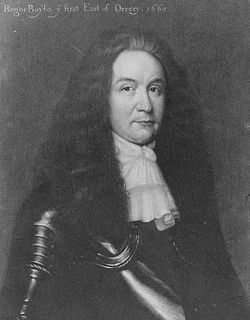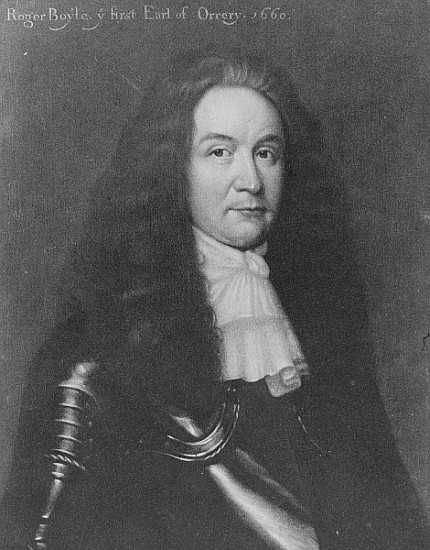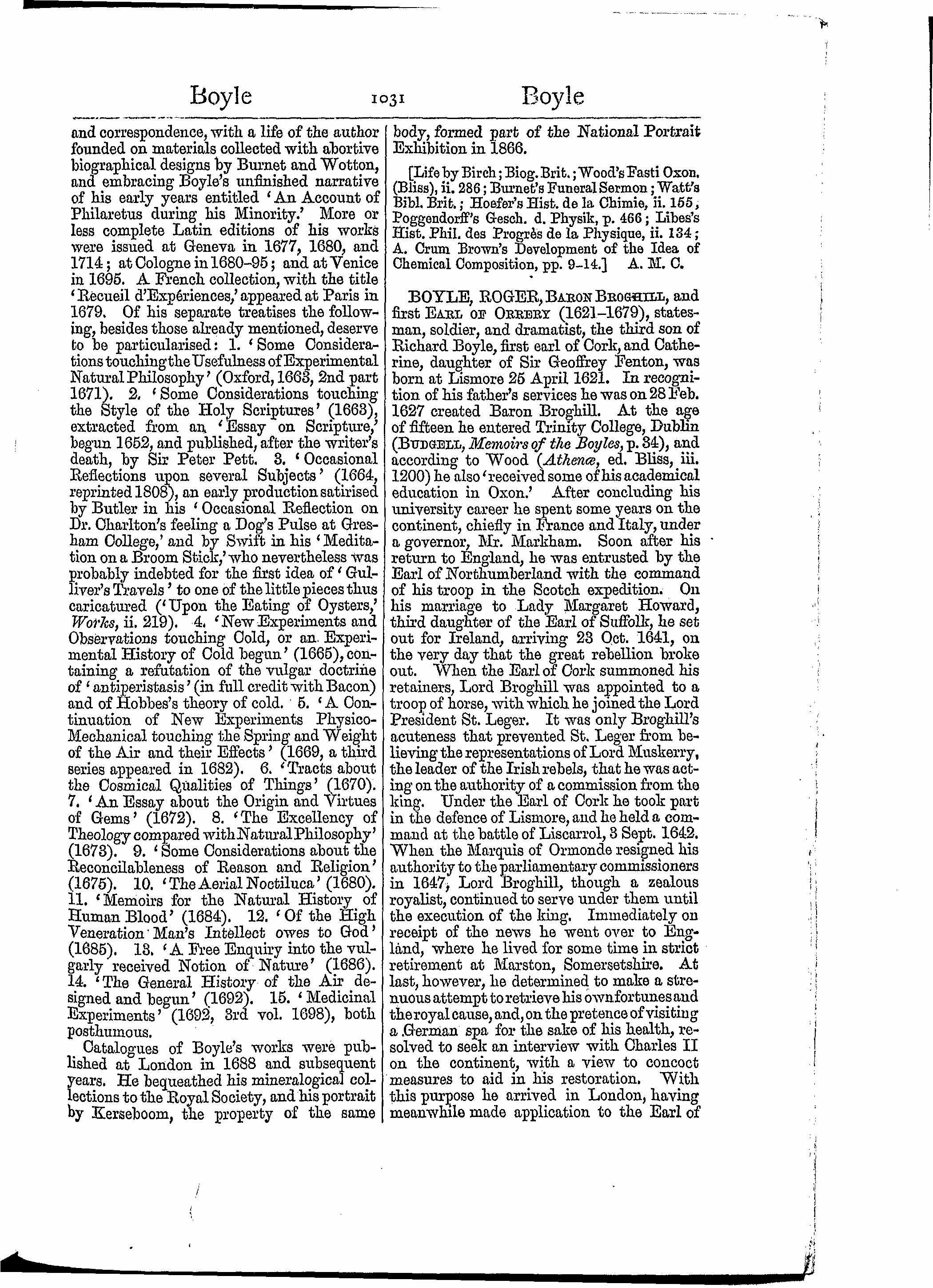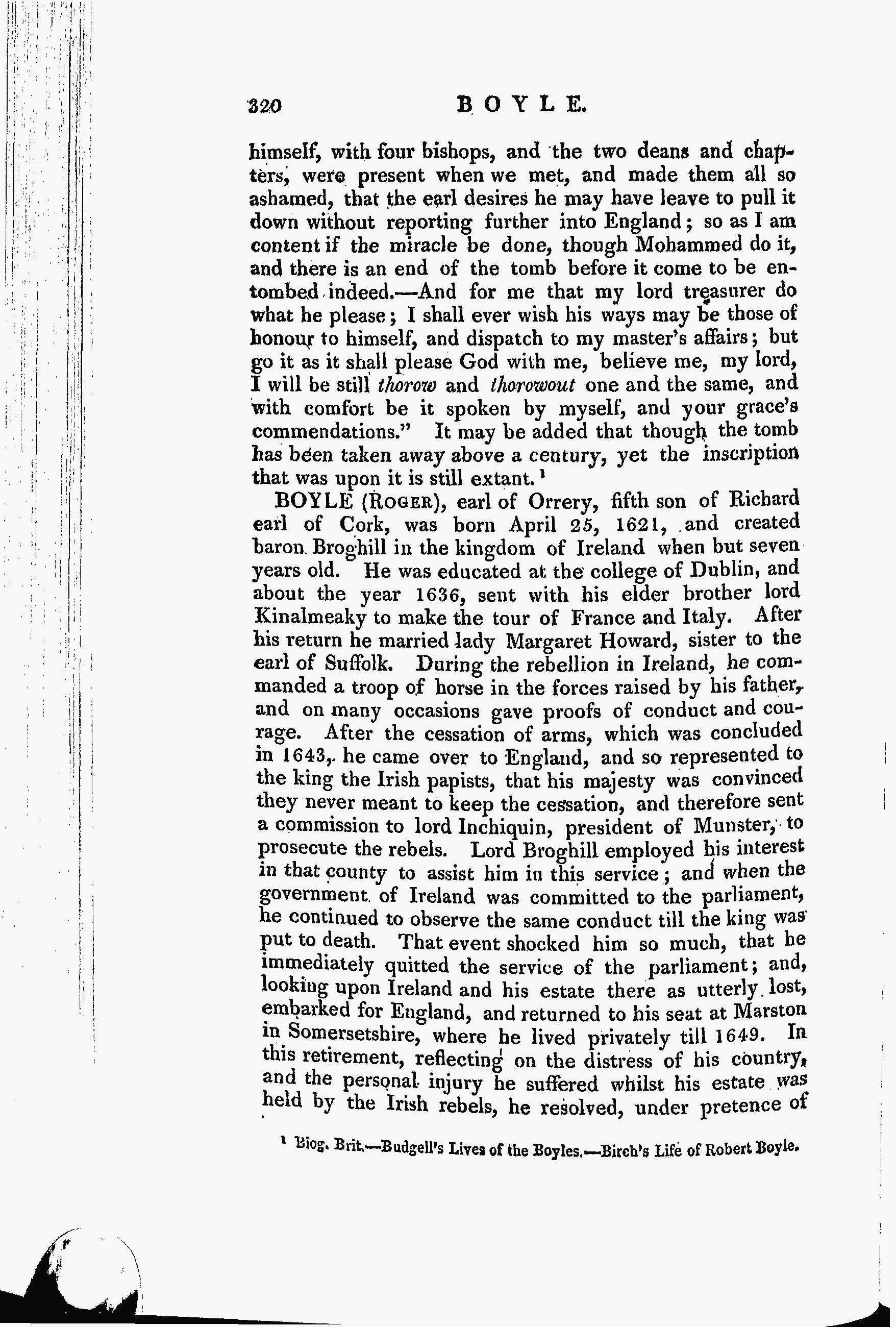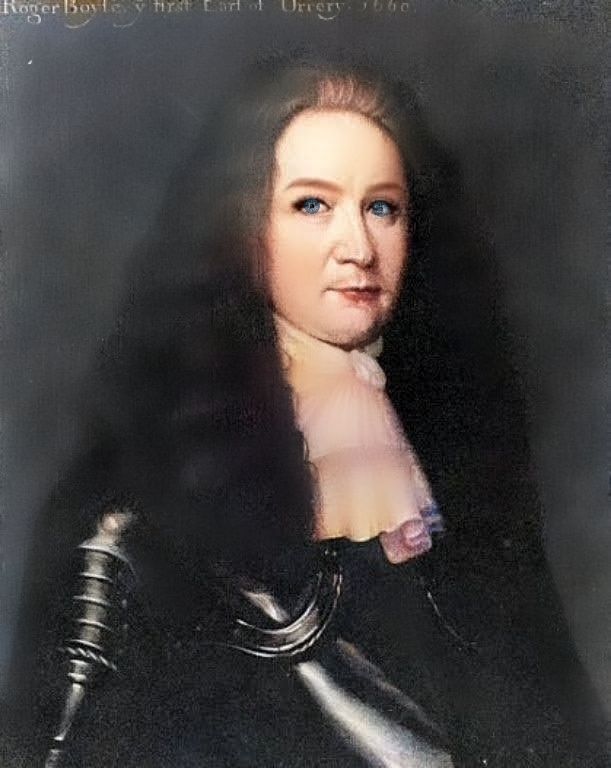Cannot verify accuracy of dates or places.
I found an accurate photo of Roger Boyle that has not been altered.
Children and siblings may not be correct. Copy at your own risk.
"Biography Roger Boyle, 1st Earl of Orrery, 1621~1679"
Irish Protestant nobleman who fought the Confederates and became prominent in Commonwealth and Protectorate politics
Roger Boyle, Born in Leicestershire, England,
21 April 1621, Roger Boyle was the third surviving son of Richard Boyle, first Earl of Cork, one of the most powerful landowners in the province of Munster. Boyle Created Baron Broghill in February 1628. After attending Trinity College, Dublin, and Gray's Inn, London, he completed his education by traveling through France and Italy and lodging for a time with the Calvinist theologian Giovanni Diodati in Geneva, which reinforced his commitment to Protestantism.
Upon his return to England, Broghill's elder brother Richard, later the first Earl of Burlington, introduced him into the court of Charles I and Henrietta Maria. In 1639, Broghill attended the King at Berwick during the First Bishops' War and commanded a troop of horse under the Earl of Northumberland. In January 1641, Broghill's marriage to Lady Margaret Howard, daughter of the Earl of Suffolk, brought a substantial dowry that enabled him to purchase an estate at Marston Bigod in Somerset.
Protestant Soldier
On the outbreak of the Irish Uprising in October 1641, Broghill returned to Ireland to defend his family's property against the rebels. His father the Earl of Cork appointed him commander of a troop of horse and he participated in the successful defence of Lismore Castle in February 1642. Despite fierce rivalry between the Earl of Cork and Lord Inchiquin for leadership of the Munster Protestants, Broghill held a command under Inchiquin at the battle of Liscarrol in September 1642.
Broghill and his brother Lord Dungarvin were sent to London In November 1642 in an attempt to discredit Inchiquin and to lobby for a member of the Boyle family to be appointed to the vacant presidency of Munster, but the mission was unsuccessful. On his return to Ireland, Broghill, like Inchiquin and other commanders, was obliged to accept the Cessation of Arms negotiated with the Confederates by the the Marquis of Ormond. However, in July 1644, Broghill joined Inchiquin in announcing that he could no longer accept the Cessation. Both peers defected to the English Parliament. Broghill's enmity towards Inchiquin intensified over his conviction that all Irish Protestants should take the Solemn League and Covenant, which Inchiquin refused to sign. Broghill became associated with the Independent faction at Westminster and welcomed the appointment of Viscount Lisle as Parliament's viceroy and commander in Ireland in 1646. Lisle's appointment challenged the authority of Ormond and threatened Inchiquin, who finally defected back to the Royalists in 1648.
After the execution of King Charles I in January 1649, Broghill's brothers Richard (now 2nd Earl of Cork) and Francis went into exile. Although he was expected to join them, Broghill declared his support for the new Commonwealth of England, which he regarded as offering the best hopes to Irish Protestants for regaining lands lost to the Confederates. Oliver Cromwell is said to have personally persuaded Broghill to support the Commonwealth and to join forces with the English army of invasion.
In October 1649, Broghill and Colonel Phayre sailed to Munster where Protestant soldiers in Lord Inchiquin's army were threatening to defect to the Parliamentarians. By December, Broghill had secured the Munster ports of Cork, Kinsale, Youghal and Dungarvan. Early in 1650, he guarded the western flank of Cromwell's winter offensive into Munster and Leinster, defeating his enemy Lord Inchiquin near Mallow, County Cork, in March. At the battle of Macroom on 10 May, Broghill attacked and defeated a Confederate force marching to relieve the siege of Clonmel. The Bishop of Ross was among those taken prisoner at Macroom. A few days later, Broghill ordered the bishop to be tortured and hanged in view of the Irish defenders of Carrigadrohid Castle in order to persuade the garrison to surrender. Broghill's severity against his enemies extended to frequent massacres of prisoners and other atrocities.
In 1651, he supported Ireton's siege of Limerick by defeating an Irish relief force commanded by Viscount Muskerry at the battle of Knocknaclashy, which was the last pitched battle of the Confederate War. When the subjugation of Ireland was complete, the Commonwealth government rewarded Broghill with large tracts of confiscated Irish land.
Protectorate & Restoration
An active participant in Commonwealth politics, Broghill supported the establishment of Cromwell's Protectorate. In March 1655, he was appointed Lord President of the Council for Scotland in Edinburgh, where he worked energetically to reconcile the Scots to the Protectorate régime and the enforced union with England. Although he was personally popular with the Scots, his efforts on behalf of the Protectorate met with limited success. However, he found favour with Henry Cromwell, who regularly sought his advice over the government of Ireland.
Broghill was elected MP for Cork in the First Protectorate Parliament where he attempted to reconcile the republican "Commonwealthsmen" with the supporters of the Protectorate. He criticised the military government of the Major-Generals that was initiated after the failure of the First Protectorate Parliament and, as a member of the Second Protectorate Parliament, was a leader of the faction that urged Cromwell to accept the Crown in order to stabilise the constitution and government of England, Ireland and Scotland. Although he was discouraged by Cromwell's refusal, Broghill accepted a place in the controversial "Other House" appointed as a second chamber of Parliament in 1658. Broghill supported Richard Cromwell after Oliver's death but returned to Ireland after the fall of the Protectorate. He carefully observed events during 1659 and transferred his allegiance to Charles II when the Restoration seemed certain.
Broghill was elected MP for Arundel in the Convention Parliament that preceded the Restoration. He found favour with King Charles II who created him Earl of Orrery in September 1660, appointed him one of the three Lord Justices of Ireland and made him Lord President of Munster. Orrery worked tirelessly to promote Protestant interests in Ireland and to denigrate the Catholics, often in opposition to the Lord Lieutenant, the Duke of Ormond. In alliance with the Duke of Buckingham, Orrery succeeded in forcing Ormond's dismissal in 1669, but he was not appointed to replace him as he hoped. Instead his political enemies attempted to impeach him for misconduct in the administration of Munster. Although the attempt failed, the presidency of Munster was abolished in 1672 and Orrery was not granted another office.
In addition to his career as a soldier, statesman and administrator, Lord Orrery was a noted writer. He wrote several anti-Catholic political tracts, a lengthy novel, Parthenissa, as well as a number of plays that were performed in London and Dublin.
Sources:
T. F. Henderson, Roger Boyle, Baron Broghill and first Earl of Orrery, DNB, 1885
Toby Barnard, Roger Boyle, first earl of Orrery, Oxford DNB, 2004
James Scott Wheeler, Cromwell in Ireland (New York 1999)
-----------------------------------------------------------------
Roger Married, Margaret Howard, Countess of Orrery, January 27, 1641, Westminster, England.
CHILDREN
1. Sir Charles Boyle, 3rd Viscount Dungarvan, 1639~1694, BIRTH: September 12, 1639, Munster Cork County, Ireland.
2. Lady Margaret Ann Boyle McBride, BIRTH: May 5, 1636, Burren County, Mayo, Ireland. DEATH: December 27, 1869, St Martins Isles of Sicilly Unitary Authority, Cornwell, England.
3. Margaret Boyle Countess of Inchiquin, 1640~1683, BIRTH: June 1, 1640, Burren County, Ireland. DEATH: December 27, 1683, St Martins, in the Field, London, England.
4. Richard Boyle, 1st Earl of Burlington, 1645~1681, Dublin, Dublin, Ireland.
5. Elizabeth Boyle Wingfield, 1645~1709, Youghal, Cork County, Dublin , Dublin, Ireland.
6. Colonel Henry of Castlemartyr Boyle, 1646~1679, August 24, 1646, Castlemartyr, Cork County, Ireland.
7. Roger Boyle 2nd Earl of Orrery, 1647~1682, BIRTH: August 24, 1646, Christ Church, Dublin, Ireland, United Kingdom, DEATH: March 29, 1682, Youghal, Cork County, Ireland.
8. Catherine Boyle, 1653~1681, Youghal, Cork County, Ireland.
9. Barbara Boyle, 1662~1682, Youghal, Cork County, Ireland.
PARENTS
Richard Boyle, First Earl of Cork, 1566~1643
Catherine Fenton, 1565~1629
(Parents Marriage: November 6, 1603, Limerick, Ireland.)
SIBLINGS
1. Dorothy Boyle, 1606~1668
2. Roger Boyle, 1606~1615
3. Sarah Boyle Digby, 1609~1633
4. Lady Joan Boyle Fitzgerald, 1611~1656
5. Richard Boyle, 1612~1698
6. Katherine Boyle Jones, 1615~1691
7. Mary Boyle Rich, 1624~1678
8. Robert Boyle, 1627~1691
Roger Boyle of Orrery
BIRTH: April 25, 1621, Lismore County, Waterford, Ireland.
DEATH: October 16, 1679, Lismore County, Waterford, Ireland.
BURIAL: October 18, 1679, Castlemagner Cemetery, Castlemanger, Cork County, Ireland.
Roger Married, Margaret Howard, (1622~1689), January 27, 1641, Westminster, London, England.
CHILDREN
1. Margaret Ann Boyle McBride, 1636~1869
2. Charles Boyle, 1639~1694
3. Margaret Boyle, 1640~1683
4. Elizabeth Boyle Wingfield, 1645~1709
5. Richard Boyle, 1645~1681
6. Henry Boyle, 1646~1693
7. Roger Boyle, 1647~1682
8. Catherine Boyle, 1653~1681
9. Barbara Boyle, 1662~1682
PARENTS
Richard Boyle, 1st Earl of Cork, 1566~1643
Catherine Fenton, 1565~1629
SIBLINGS
1. Sarah Boyle, 1609~1633
2. Lettice Boyle, 1610~1657
3. Joan Boyle, 1611~1656
4. Dorothy Boyle, 1617~1668
5. Lewis Boyle, 1619~1643
6. Francis Wise Boyle, 1623~1699
7. Lady Mary Boyle, 1624~1678
8. Margaret Boyle, 1629~1637
Cannot verify accuracy of dates or places.
I found an accurate photo of Roger Boyle that has not been altered.
Children and siblings may not be correct. Copy at your own risk.
"Biography Roger Boyle, 1st Earl of Orrery, 1621~1679"
Irish Protestant nobleman who fought the Confederates and became prominent in Commonwealth and Protectorate politics
Roger Boyle, Born in Leicestershire, England,
21 April 1621, Roger Boyle was the third surviving son of Richard Boyle, first Earl of Cork, one of the most powerful landowners in the province of Munster. Boyle Created Baron Broghill in February 1628. After attending Trinity College, Dublin, and Gray's Inn, London, he completed his education by traveling through France and Italy and lodging for a time with the Calvinist theologian Giovanni Diodati in Geneva, which reinforced his commitment to Protestantism.
Upon his return to England, Broghill's elder brother Richard, later the first Earl of Burlington, introduced him into the court of Charles I and Henrietta Maria. In 1639, Broghill attended the King at Berwick during the First Bishops' War and commanded a troop of horse under the Earl of Northumberland. In January 1641, Broghill's marriage to Lady Margaret Howard, daughter of the Earl of Suffolk, brought a substantial dowry that enabled him to purchase an estate at Marston Bigod in Somerset.
Protestant Soldier
On the outbreak of the Irish Uprising in October 1641, Broghill returned to Ireland to defend his family's property against the rebels. His father the Earl of Cork appointed him commander of a troop of horse and he participated in the successful defence of Lismore Castle in February 1642. Despite fierce rivalry between the Earl of Cork and Lord Inchiquin for leadership of the Munster Protestants, Broghill held a command under Inchiquin at the battle of Liscarrol in September 1642.
Broghill and his brother Lord Dungarvin were sent to London In November 1642 in an attempt to discredit Inchiquin and to lobby for a member of the Boyle family to be appointed to the vacant presidency of Munster, but the mission was unsuccessful. On his return to Ireland, Broghill, like Inchiquin and other commanders, was obliged to accept the Cessation of Arms negotiated with the Confederates by the the Marquis of Ormond. However, in July 1644, Broghill joined Inchiquin in announcing that he could no longer accept the Cessation. Both peers defected to the English Parliament. Broghill's enmity towards Inchiquin intensified over his conviction that all Irish Protestants should take the Solemn League and Covenant, which Inchiquin refused to sign. Broghill became associated with the Independent faction at Westminster and welcomed the appointment of Viscount Lisle as Parliament's viceroy and commander in Ireland in 1646. Lisle's appointment challenged the authority of Ormond and threatened Inchiquin, who finally defected back to the Royalists in 1648.
After the execution of King Charles I in January 1649, Broghill's brothers Richard (now 2nd Earl of Cork) and Francis went into exile. Although he was expected to join them, Broghill declared his support for the new Commonwealth of England, which he regarded as offering the best hopes to Irish Protestants for regaining lands lost to the Confederates. Oliver Cromwell is said to have personally persuaded Broghill to support the Commonwealth and to join forces with the English army of invasion.
In October 1649, Broghill and Colonel Phayre sailed to Munster where Protestant soldiers in Lord Inchiquin's army were threatening to defect to the Parliamentarians. By December, Broghill had secured the Munster ports of Cork, Kinsale, Youghal and Dungarvan. Early in 1650, he guarded the western flank of Cromwell's winter offensive into Munster and Leinster, defeating his enemy Lord Inchiquin near Mallow, County Cork, in March. At the battle of Macroom on 10 May, Broghill attacked and defeated a Confederate force marching to relieve the siege of Clonmel. The Bishop of Ross was among those taken prisoner at Macroom. A few days later, Broghill ordered the bishop to be tortured and hanged in view of the Irish defenders of Carrigadrohid Castle in order to persuade the garrison to surrender. Broghill's severity against his enemies extended to frequent massacres of prisoners and other atrocities.
In 1651, he supported Ireton's siege of Limerick by defeating an Irish relief force commanded by Viscount Muskerry at the battle of Knocknaclashy, which was the last pitched battle of the Confederate War. When the subjugation of Ireland was complete, the Commonwealth government rewarded Broghill with large tracts of confiscated Irish land.
Protectorate & Restoration
An active participant in Commonwealth politics, Broghill supported the establishment of Cromwell's Protectorate. In March 1655, he was appointed Lord President of the Council for Scotland in Edinburgh, where he worked energetically to reconcile the Scots to the Protectorate régime and the enforced union with England. Although he was personally popular with the Scots, his efforts on behalf of the Protectorate met with limited success. However, he found favour with Henry Cromwell, who regularly sought his advice over the government of Ireland.
Broghill was elected MP for Cork in the First Protectorate Parliament where he attempted to reconcile the republican "Commonwealthsmen" with the supporters of the Protectorate. He criticised the military government of the Major-Generals that was initiated after the failure of the First Protectorate Parliament and, as a member of the Second Protectorate Parliament, was a leader of the faction that urged Cromwell to accept the Crown in order to stabilise the constitution and government of England, Ireland and Scotland. Although he was discouraged by Cromwell's refusal, Broghill accepted a place in the controversial "Other House" appointed as a second chamber of Parliament in 1658. Broghill supported Richard Cromwell after Oliver's death but returned to Ireland after the fall of the Protectorate. He carefully observed events during 1659 and transferred his allegiance to Charles II when the Restoration seemed certain.
Broghill was elected MP for Arundel in the Convention Parliament that preceded the Restoration. He found favour with King Charles II who created him Earl of Orrery in September 1660, appointed him one of the three Lord Justices of Ireland and made him Lord President of Munster. Orrery worked tirelessly to promote Protestant interests in Ireland and to denigrate the Catholics, often in opposition to the Lord Lieutenant, the Duke of Ormond. In alliance with the Duke of Buckingham, Orrery succeeded in forcing Ormond's dismissal in 1669, but he was not appointed to replace him as he hoped. Instead his political enemies attempted to impeach him for misconduct in the administration of Munster. Although the attempt failed, the presidency of Munster was abolished in 1672 and Orrery was not granted another office.
In addition to his career as a soldier, statesman and administrator, Lord Orrery was a noted writer. He wrote several anti-Catholic political tracts, a lengthy novel, Parthenissa, as well as a number of plays that were performed in London and Dublin.
Sources:
T. F. Henderson, Roger Boyle, Baron Broghill and first Earl of Orrery, DNB, 1885
Toby Barnard, Roger Boyle, first earl of Orrery, Oxford DNB, 2004
James Scott Wheeler, Cromwell in Ireland (New York 1999)
-----------------------------------------------------------------
Roger Married, Margaret Howard, Countess of Orrery, January 27, 1641, Westminster, England.
CHILDREN
1. Sir Charles Boyle, 3rd Viscount Dungarvan, 1639~1694, BIRTH: September 12, 1639, Munster Cork County, Ireland.
2. Lady Margaret Ann Boyle McBride, BIRTH: May 5, 1636, Burren County, Mayo, Ireland. DEATH: December 27, 1869, St Martins Isles of Sicilly Unitary Authority, Cornwell, England.
3. Margaret Boyle Countess of Inchiquin, 1640~1683, BIRTH: June 1, 1640, Burren County, Ireland. DEATH: December 27, 1683, St Martins, in the Field, London, England.
4. Richard Boyle, 1st Earl of Burlington, 1645~1681, Dublin, Dublin, Ireland.
5. Elizabeth Boyle Wingfield, 1645~1709, Youghal, Cork County, Dublin , Dublin, Ireland.
6. Colonel Henry of Castlemartyr Boyle, 1646~1679, August 24, 1646, Castlemartyr, Cork County, Ireland.
7. Roger Boyle 2nd Earl of Orrery, 1647~1682, BIRTH: August 24, 1646, Christ Church, Dublin, Ireland, United Kingdom, DEATH: March 29, 1682, Youghal, Cork County, Ireland.
8. Catherine Boyle, 1653~1681, Youghal, Cork County, Ireland.
9. Barbara Boyle, 1662~1682, Youghal, Cork County, Ireland.
PARENTS
Richard Boyle, First Earl of Cork, 1566~1643
Catherine Fenton, 1565~1629
(Parents Marriage: November 6, 1603, Limerick, Ireland.)
SIBLINGS
1. Dorothy Boyle, 1606~1668
2. Roger Boyle, 1606~1615
3. Sarah Boyle Digby, 1609~1633
4. Lady Joan Boyle Fitzgerald, 1611~1656
5. Richard Boyle, 1612~1698
6. Katherine Boyle Jones, 1615~1691
7. Mary Boyle Rich, 1624~1678
8. Robert Boyle, 1627~1691
Roger Boyle of Orrery
BIRTH: April 25, 1621, Lismore County, Waterford, Ireland.
DEATH: October 16, 1679, Lismore County, Waterford, Ireland.
BURIAL: October 18, 1679, Castlemagner Cemetery, Castlemanger, Cork County, Ireland.
Roger Married, Margaret Howard, (1622~1689), January 27, 1641, Westminster, London, England.
CHILDREN
1. Margaret Ann Boyle McBride, 1636~1869
2. Charles Boyle, 1639~1694
3. Margaret Boyle, 1640~1683
4. Elizabeth Boyle Wingfield, 1645~1709
5. Richard Boyle, 1645~1681
6. Henry Boyle, 1646~1693
7. Roger Boyle, 1647~1682
8. Catherine Boyle, 1653~1681
9. Barbara Boyle, 1662~1682
PARENTS
Richard Boyle, 1st Earl of Cork, 1566~1643
Catherine Fenton, 1565~1629
SIBLINGS
1. Sarah Boyle, 1609~1633
2. Lettice Boyle, 1610~1657
3. Joan Boyle, 1611~1656
4. Dorothy Boyle, 1617~1668
5. Lewis Boyle, 1619~1643
6. Francis Wise Boyle, 1623~1699
7. Lady Mary Boyle, 1624~1678
8. Margaret Boyle, 1629~1637
Family Members
Advertisement
Explore more
Sponsored by Ancestry
Advertisement
